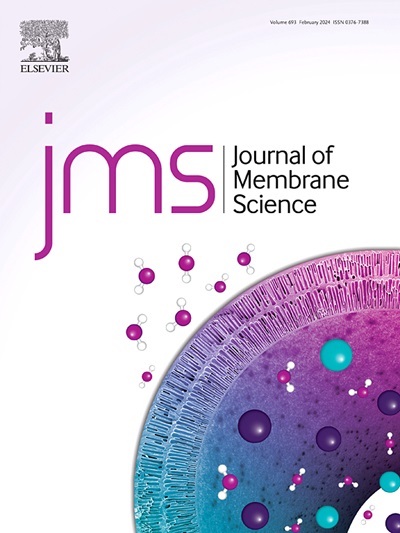Fabrication of ultra-permeable micelle-based isoporous membranes
IF 8.4
1区 工程技术
Q1 ENGINEERING, CHEMICAL
引用次数: 0
Abstract
Membrane separation technology has garnered significant interest due to its energy efficiency, environmental benefits, and molecular sieving capabilities. Polymeric membranes, despite their cost-effectiveness and processability, face challenges in balancing water permeance and selectivity, primarily due to non-uniform or sparse pore structures. Block copolymer (BCP)-based isoporous membranes, fabricated via strategies like the self-assembly and non-solvent-induced phase separation (SNIPS), offer improved pore uniformity and separation performance. This work introduces an alternative strategy to produce isoporous membranes by combining phase separation and surface tension driven micelle spreading at the air/water interface. The resulting membranes feature ordered isopores (ca. 10 nm) and exceptional water permeance (ca. 1450 L m−2 h−1 bar−1), enabling precise nanoparticle separation. The membrane demonstrates stability under 20 psi pressure, with tunable thickness (via micellar solution volume) and pore size (via water temperature). The work advances the design of high-performance isoporous membranes, offering potential applications in ultrafiltration, biotechnology, and environmental remediation.
超渗透胶束基等孔膜的制备
膜分离技术由于其能源效率、环境效益和分子筛分能力而获得了极大的兴趣。尽管聚合物膜具有成本效益和可加工性,但在平衡透水性和选择性方面仍面临挑战,主要原因是孔隙结构不均匀或稀疏。基于嵌段共聚物(BCP)的等孔膜通过自组装和非溶剂诱导相分离(SNIPS)等策略制备,可改善孔隙均匀性和分离性能。这项工作介绍了一种结合相分离和表面张力驱动胶束在空气/水界面扩散来生产等孔膜的替代策略。所得膜具有有序的等孔(约10 nm)和优异的透水性(约1450 L m−2 h−1 bar−1),能够实现精确的纳米颗粒分离。该膜在20 psi压力下表现出稳定性,具有可调节的厚度(通过胶束溶液体积)和孔径(通过水温)。这项工作推进了高性能等孔膜的设计,在超滤、生物技术和环境修复方面具有潜在的应用前景。
本文章由计算机程序翻译,如有差异,请以英文原文为准。
求助全文
约1分钟内获得全文
求助全文
来源期刊

Journal of Membrane Science
工程技术-高分子科学
CiteScore
17.10
自引率
17.90%
发文量
1031
审稿时长
2.5 months
期刊介绍:
The Journal of Membrane Science is a publication that focuses on membrane systems and is aimed at academic and industrial chemists, chemical engineers, materials scientists, and membranologists. It publishes original research and reviews on various aspects of membrane transport, membrane formation/structure, fouling, module/process design, and processes/applications. The journal primarily focuses on the structure, function, and performance of non-biological membranes but also includes papers that relate to biological membranes. The Journal of Membrane Science publishes Full Text Papers, State-of-the-Art Reviews, Letters to the Editor, and Perspectives.
 求助内容:
求助内容: 应助结果提醒方式:
应助结果提醒方式:


